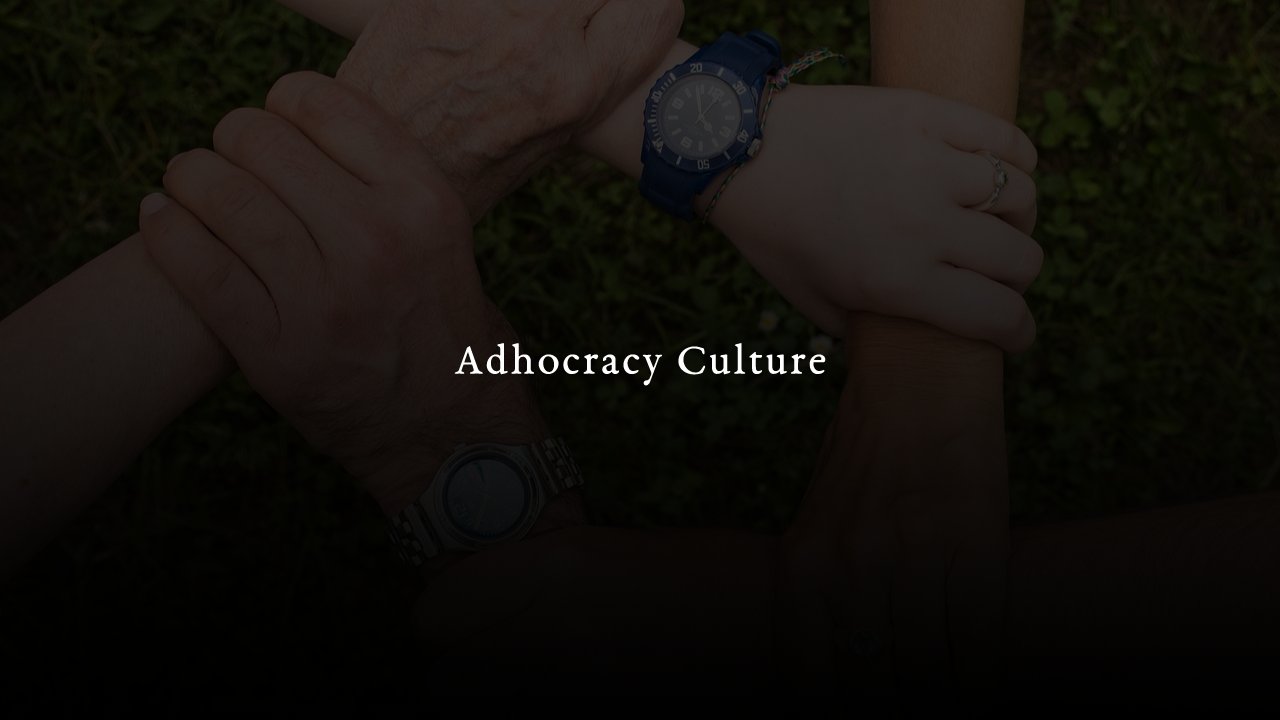Introduction
In today’s fast-paced and ever-changing business environment, organizations must be flexible and adaptable to remain competitive. This is where adhocracy culture comes in – a management approach that emphasizes innovation, risk-taking, and creativity. This article argues that adhocracy culture represents a key structure for organizations to thrive in the 21st century, an alternative that can help businesses to achieve these goals. We will explore the key differences between bureaucratic and adhocratic structures, the focus of adhocracy culture, the characteristics of organizational culture, and the advantages and disadvantages of adhocracy culture.
Table of Contents
- Introduction
- What is Adhocracy Culture?
- Organizational Challenges Of A Post-Pandemic Workplace
- The Adhocracy Culture Focus, Pros and Cons
- Adhocracy: Evidences, Examples and Case Studies
- Adhocracy versus Bureaucracy: Difference, Relationship and Balance
- 5 Effective Ways to Implement Adhocracy Culture in Companies
- Conclusions
- References
What is Adhocracy Culture?
Adhocracy culture is a way of organizing a company or team that values flexibility, innovation, and collaboration. In an adhocracy, decision-making is decentralized, which means that everyone has the freedom to share their ideas and make decisions that contribute to the success of the team or company.
In an Adhocratic organization, there is a significant focus on decentralization and a bottom-up approach, with minimal formalization and heavy emphasis on training, mutual adjustment, and horizontal job specialization. Additionally, the support staff plays a crucial role in supporting the Adhocracy's operations.
Adhocracy is especially useful in dynamic environments where things are constantly changing (Toffler, 1990), as it allows companies to adapt quickly and respond to new challenges. By encouraging creativity and innovation, adhocratic cultures help teams and companies stay ahead of the curve and come up with new and better ways of doing things.
Adhocracy is like a jazz band.
Just like in jazz, where each member of the band has the freedom to improvise and contribute their unique sound to the overall melody, adhocracy culture values individual creativity and innovation. The band members in jazz work together to create something greater than the sum of their individual parts, just as adhocracy culture emphasizes collaboration and teamwork to achieve shared goals. And just as jazz musicians adapt to each other’s playing and the evolving mood of the music, adhocracy culture is adaptable and dynamic, allowing teams to respond quickly to changing circumstances and come up with new and innovative solutions.
Organizational Challenges Of A Post-Pandemic Workplace
Traditional organizational structures that prioritize stability, predictability, and hierarchy are no longer effective in the current business climate. In the past, companies operated in relatively stable environments where long-term planning and control were essential for success. This required a top-down approach to decision-making, with managers at the top of the hierarchy making decisions and delegating tasks to subordinates. However, in today’s business climate, there are further challenges: technological advances and globalization have created a more complex and dynamic business environment, where change is rapid and constant. As a result, traditional organizational structures can be too slow to adapt to change, too rigid in their decision-making, and too focused on maintaining the status quo.
Adhocracy culture is a new approach that offers a solution to the challenges organizations face in a dynamic and unpredictable market (Galbraith, 2014).
The Adhocracy Culture Focus, Pros and Cons
The adhocracy culture places a strong emphasis on flexibility, innovation and collaboration (Mintzberg, 1979).
Adhocracy is characterized by a decentralized and collaborative structure that encourages employees to take risks, experiment with new approaches, and learn from failure.
Adhocracy culture values autonomy and empowerment, and it provides employees with the freedom and resources they need to pursue their ideas.
Actually, all that glitter is not gold.
Adhocracy culture has several advantages and disadvantages that organizations need to consider before implementing it.
Adhocratic approach advantages:
- Innovation: Adhocracy culture encourages innovation and creativity, which can lead to new products, services, and processes.
- Flexibility: Adhocracy culture is flexible and adaptable, which allows organizations to respond quickly to changing market conditions.
- Employee empowerment: Adhocracy culture values autonomy and empowerment, which can increase employee engagement and job satisfaction.
- Collaboration: Adhocracy culture promotes collaboration and teamwork, which can lead to better decision-making and problem-solving.
Adhocratic approach downsides:
- Lack of structure: Adhocracy culture can lack structure and accountability, which can lead to confusion and chaos.
- Risk-taking: Adhocracy culture encourages risk-taking and experimentation, which can lead to failure and uncertainty.
- Resistance to change: Adhocracy culture can be difficult to implement in organizations that are resistant to change and new ideas.
- Lack of control: Adhocracy culture can be challenging to manage, as decision-making is decentralized and there may be a lack of clear lines of authority.
Adhocracy: Evidences, Examples and Case Studies
Research shows that organizations with an adhocracy culture are more innovative and adaptable than those with traditional structures (Mintzberg, 1989). In addition, adhocracy culture has been linked to increased employee engagement and job satisfaction, which can lead to higher productivity and retention rates.
Several companies have successfully implemented adhocracy culture, including Google, which is known for its innovative and experimental approach to management. Further adhocracy examples include NASA, UNICEF, Wikipedia or W.L. Gore & Associates, which encourages employees to take ownership of their projects, and Zappos, which focuses on employee empowerment and customer-centricity.
An interesting case study is Valve Corporation: this video game developer embrace an adhocracy culture that allows employees to work on projects that interest them. The company has no managers or hierarchy, and decisions are made collaboratively by the employees working on a particular project. Valve’s approach has led to the development of hit games such as Half-Life and Portal.-
Adhocracy versus Bureaucracy: Difference, Relationship and Balance
Bureaucratic structure is the traditional hierarchical organizational structure that is commonly used in many businesses. It is characterized by a top-down approach, strict hierarchy, with clear lines of authority and formal rules and procedures. In contrast, from an organizational design point of view, adhocracy is a more flexible and decentralized structure that allows for greater collaboration and creativity. The table below summarizes the key differences between bureaucratic and adhocratic structures.
| Adhocratic Structure | Bureaucratic Structure | |
|---|---|---|
| Mechanism | Decentralized | Hierarchical |
| Rules and procedures | Flexible | Formal |
| Government | Collaborative | Clear lines of authority |
| Emphasis on | Innovation | Stability |
| Focus on | Creativity | Efficiency |
| Autonomy | Greater | Limited |
| Decision-making | Decentralized | Centralized |
Adhocracy Culture vs. Clan Culture
Clan culture is another alternative organizational structure that is focused on collaboration and teamwork: it places a greater emphasis on people orientation and internal values.
As we have witnessed, Adhocracy culture is all about being creative, flexible, and able to change quickly when needed. People who work in an adhocracy culture are encouraged to take risks and try new things. On the other hand, clan culture is focused on building a strong sense of community within the company. People who work in a clan culture are encouraged to work together and value teamwork. Decisions are often made by everyone agreeing together. Adhocracy culture can be better for companies that need to change quickly, while clan culture can be better for companies that want everyone to work together closely.
5 Effective Ways to Implement Adhocracy Culture in Companies
Applying adhocracy culture to a company allows to synchronize the organizational (internal) drivers to the actual environment (external) drivers and so can be a valuable approach to increase innovation and adaptability. Obviously, a change management project is crucial in almost all cases, but here are some practical steps to properly apply adhocracy:
- Foster a culture of creativity: Encourage employees to think outside the box and pursue new ideas. Create a safe and supportive environment where employees feel empowered to take risks and experiment with new approaches;
- Develop a flexible organizational structure: Adhocracy culture values flexibility and adaptability, so it is important to create a structure that supports these values. Consider a flat organizational structure that promotes collaboration and teamwork, and allows employees to work on cross-functional projects;
- Emphasize autonomy and empowerment: Adhocracy culture values autonomy and empowerment, so it is important to give employees the freedom to make decisions and take ownership of their work. Encourage employees to take initiative and provide them with the resources and support they need to succeed;
- Encourage experimentation: Adhocracy culture values experimentation and learning from failure. Encourage employees to try new approaches and experiment with different ideas. Celebrate both successes and failures as opportunities to learn and grow;
- Focus on continuous improvement: Adhocracy culture values continuous improvement and innovation. Encourage employees to seek out new knowledge and stay up-to-date on industry trends and best practices. Provide opportunities for professional development and training.
Conclusions
In conclusion, adhocracy culture is a valuable approach that can help organizations thrive in the current business climate. By fostering a culture of innovation, risk-taking, and creativity, organizations can remain competitive and adapt to changing market conditions. As the business world continues to evolve, adhocracy culture will become increasingly important for organizations that want to succeed. Clearly, not all environments are suitable for an adhocratic approach, it is not a one-size-fits-all solution. In some cases, Adhocracy can also be mixed with other approaches: Galbraith already found this out in 1973 when he studied Boeing Co structure.
References
GALBRAITH, J. K. (2014). The anatomy of power. Boston: Houghton Mifflin Company.
MINTZBERG, H. (1979). The Structuring of Organizations. New Jersey: Prentice-Hall.
MINTZBERG, H. (1989). Mintzberg on management. New York: Free Press.
TOFFLER, A. (1990). Powershift: Knowledge, wealth, and violence at the edge of the 21st century. New York: Bantam books.

